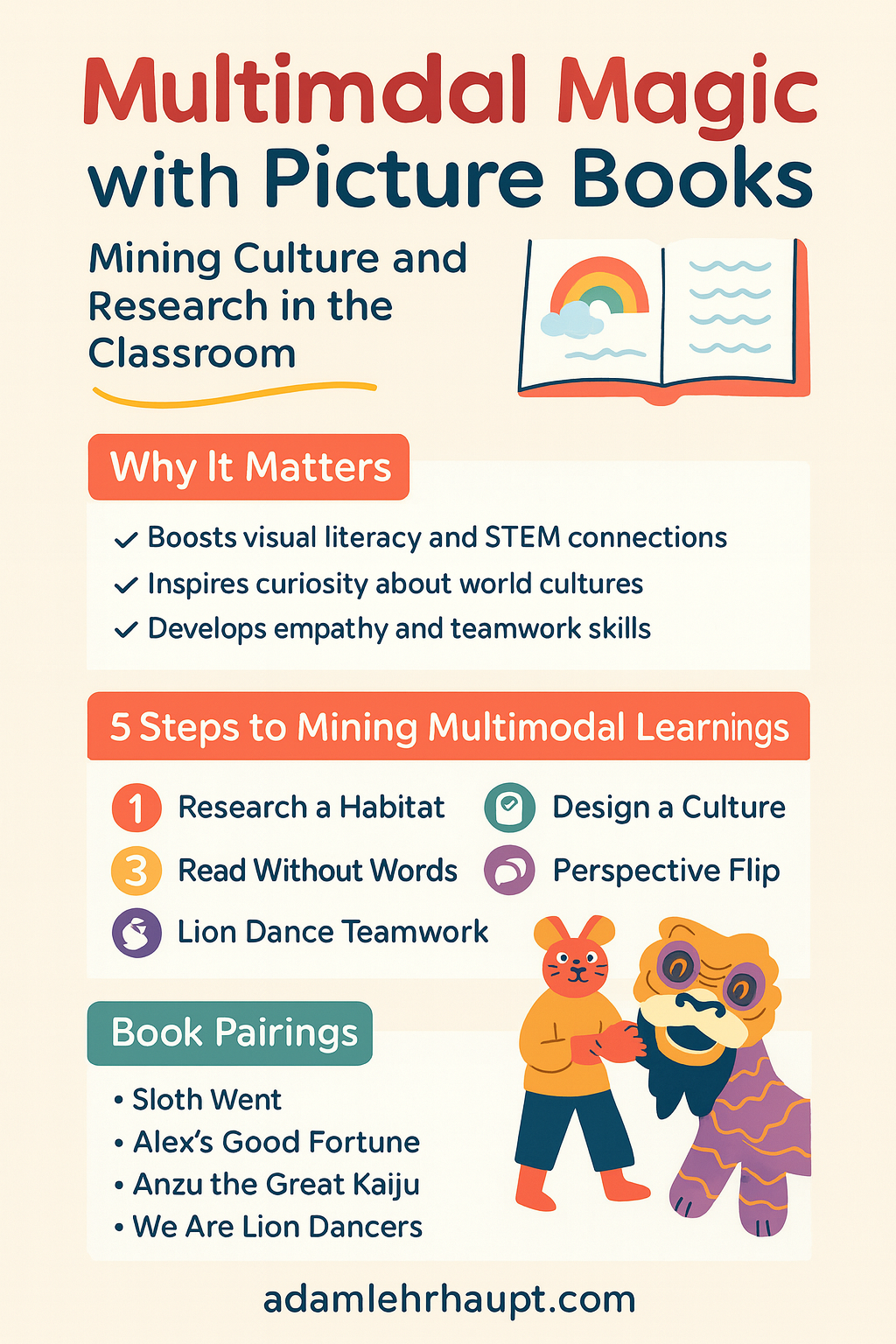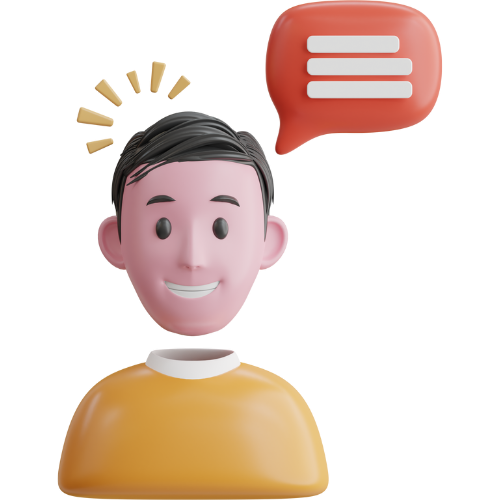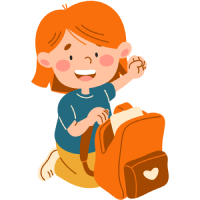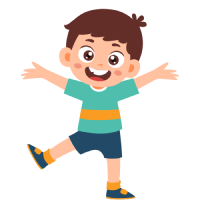You ever have one of those teaching moments where you think, “Oh, this is going to be great,” and then three minutes later the kids are looking at you like you’ve just asked them to explain quantum physics in interpretive dance?
Yep. Been there.
It’s not that they aren’t engaged—it’s that the lesson isn’t speaking their language… yet.
That’s where diverse picture books for multimodal learning come in. They don’t just tell a story; they show it, invite you into it, and give you ten different ways to explore it—whether your students learn best through reading, seeing, hearing, moving, or doing. Today, I’m pulling from my chat with author-illustrator Benson Shum (of Sloth Went, Anzu the Great Kaiju, Alex’s Good Fortune, and We Are Lion Dancers) to show you how to use diverse, culturally rich picture books as springboards for research, creative projects, and serious cross-curricular magic.
TL;DR (All the good stuff, none of the fluff)
- Use diverse picture books for multimodal learning to connect literacy, visual arts, STEM, and cultural studies in one lesson.
- Build in research opportunities—let students fact-check details, interview relatives about traditions, or dig into the history behind the story.
- Activities work across K–5, with easy ways to adapt for homeschool families and libraries.
- Bonus: There’s a free downloadable resource pack at the bottom.
1. Turn Stories into Research Adventures
The Problem: Reading is fun, but finding ways to connect it to inquiry and investigation? That’s where some lessons stall out.
The Picture Book Solution: In Sloth Went, Benson dove deep into sloth habitats, diets, and behavior before even touching a pencil. Imagine if your students became mini-researchers like that.
Try This:
- Read Sloth Went aloud.
- Split students into “fact squads” (diet, habitat, predators, etc.).
- Provide books, safe websites, and visual references.
- Have each group present what’s true, what’s “artistic license,” and one fun fact not in the story.
Curriculum Connection:
- CCSS.ELA-LITERACY.W.3.7 – Conduct short research projects that build knowledge about a topic.
- Next Generation Science Standards (NGSS): 3-LS4-3 – Construct an argument with evidence that in a particular habitat some organisms can survive well.
Pro Tip: Students love catching “mistakes” in books. Let them—it turns reading into detective work.
2. Explore Cultural Traditions Through Story and Craft
The Problem: We want our students to appreciate cultures outside their own, but cultural units can feel flat if they’re all worksheet and no wonder.
The Picture Book Solution: Alex’s Good Fortune introduces Lunar New Year through a personal, family-centered lens. Benson even offers free activity guides (download Benson’s activity guides here)—dumpling recipes, zodiac banners, and more.
Try This:
- After reading, invite students to share a tradition from their own lives.
- Compare them in a class “culture quilt” (paper squares with drawings or short descriptions).
- Make a collaborative classroom book: Our Traditions.
Curriculum Connection:
- CCSS.ELA-LITERACY.SL.2.4 – Tell a story or recount an experience with appropriate facts and relevant, descriptive details.
- Social Studies C3 Framework: D2.Geo.4.K-2 – Explain how weather, climate, and cultural environment influence the way people live.
Pro Tip: These kinds of activities make diverse picture books for multimodal learning a bridge between literacy and social-emotional learning (SEL).
3. Build Visual Literacy Like a Disney Animator
The Problem: Kids often “read” words but skip over illustrations without noticing the clues hiding in them.
The Picture Book Solution: With an animation background, Benson treats illustrations like a second narrative. In Sloth Went, time passing is shown through an inchworm transforming into a butterfly. In Anzu the Great Kaiju, you can spot emotional shifts in Anzu’s face long before the text says it.
Try This:
- Cover the text on a page.
- Ask: “What’s happening? How do you know? What might happen next?”
- Compare predictions to the actual text.
Curriculum Connection:
- CCSS.ELA-LITERACY.RL.3.7 – Explain how specific aspects of a text’s illustrations contribute to what is conveyed by the words.
- More on using Visual Literacy in Education at Wikipedia
Pro Tip: This works beautifully for English language learners because it levels the playing field—everyone can “read” a picture.
4. Flip the Perspective
The Problem: Students can struggle with empathy and perspective-taking—skills that are crucial in both literacy and life.
The Picture Book Solution: In Anzu the Great Kaiju, Benson imagined what happens when a Godzilla-like monster doesn’t want to destroy cities. What does his family think? What about the villagers?
Try This:
- Pick a secondary character from a book.
- Write or draw the story from their point of view.
- Share and compare.
Curriculum Connection:
- CCSS.ELA-LITERACY.RL.3.6 – Distinguish their own point of view from that of the narrator or those of the characters.
Pro Tip: This is where diverse picture books for multimodal learning shine—they naturally invite multiple entry points for storytelling (text, image, sound, movement).
5. Create a Teamwork Challenge
The Problem: Group projects often become “one kid does all the work” disasters.
The Picture Book Solution: We Are Lion Dancers is a masterclass in collaboration—the front and back of the lion can’t dance without each other.
Try This:
- Give pairs of students a blanket and a task (cross the room without dropping it, “dance” in sync, etc.).
- Reflect: What worked? What was hard?
- Connect it back to the story’s themes of rhythm, trust, and shared goals.
Curriculum Connection:
- SEL Competency: Relationship Skills – Work collaboratively to plan and complete tasks.
Pro Tip: Bring in the music element—compare the lion dance drumbeat to another style. You’ve just folded music appreciation into your literacy lesson.
Bonus Ideas
- Superpower Stories: Inspired by Anzu, students choose a superpower and write how they’d use it to help their community.
- Mistake to Masterpiece: After reading The Book of Mistakes, give students an “oops” (smudge, random line) and let them turn it into art.
- Classroom Culture Fair: After a unit of diverse stories, host a mini “expo” where students showcase traditions or research projects.
Conclusion
When you weave diverse picture books for multimodal learning into your classroom, you’re not just checking boxes for literacy, art, or social studies. You’re building empathy, visual literacy, cultural understanding, and research skills—all in one shot.
And honestly? It’s more fun. For them and for you.
So grab a book, get curious, and let’s see where the story takes us.
FAQ
How can I find more diverse picture books for my classroom?
Check out this diverse classroom libraries list from Reading Rockets as well as your local library’s curated lists.
How do I adapt these lessons for K–2?
Simplify the research component—use visuals, guided questions, and group projects instead of solo reports.
What if my students are reluctant to share personal traditions or ‘don’t have any’?
Offer opt-in activities—students can research a tradition from a culture they admire instead.
How can I integrate technology into these lessons?
Use Microsoft Teams for Education (Free with a valid school email) for video book reviews, Canva for posters, and Padlet for digital culture quilts.
How do I assess multimodal learning?
Create rubrics that value multiple outputs—writing, art, oral presentations, and collaboration.
Free Download
“Multimodal Magic: Classroom Activities for Diverse Picture Books”
Includes:
- Research project template suggestions
- Culture quilt instructions
- Visual literacy prompt card ideas
- and more!




